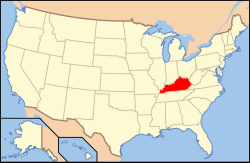
The following outline is provided as an overview of and topical guide to the United States Commonwealth of Kentucky:
Contents
- General reference
- Geography and Climatology of Kentucky
- Regions of Kentucky
- Natural geographic features of Kentucky
- Places in Kentucky
- Environment of Kentucky
- Administrative divisions of Kentucky
- Demographics of Kentucky
- Government and politics of Kentucky
- Executive branch of the government of Kentucky
- Legislative branch of the government of Kentucky
- Judicial branch of the government of Kentucky
- Federal courts in Kentucky
- Law and order in Kentucky
- Military in Kentucky
- History of Kentucky
- Historical societies in Kentucky
- History of Kentucky, by period
- History of Kentucky, by region
- History of Kentucky, by subject
- Culture of Kentucky
- Arts and letters in Kentucky
- Sports in Kentucky
- Economy and infrastructure of Kentucky
- List of people from Kentucky
- Education in Kentucky
- See also
- References
- External links
Kentucky – state located in the upper south United States of America, nicknamed the "Bluegrass State", due to the presence of bluegrass in many of the pastures throughout the state. As classified by the United States Census Bureau, Kentucky is a Southern state, in the East South Central region. Kentucky is the 37th largest state in terms of total area, the 36th largest in land area, and ranks 26th in population. Originally a part of Virginia, in 1792 it became the 15th state to join the Union. Kentucky is designated a commonwealth by the Kentucky Constitution and is formally known as the "Commonwealth of Kentucky." [1]



